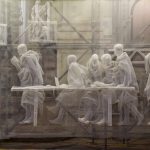 Melanie Veasey | SCULPTURE SCRIPT
Melanie Veasey | SCULPTURE SCRIPTThe Recycle Group recently presented the finale to the Royal Academy’s History of Sculpture Course (January to March 2019). Locating their contemporary work within an art-historical context this article connects previous artistic pioneers with these twenty-first-century innovators.
Few artists have captured the twenty-first-century consumer zeitgeist with as much curiosity, cynicism, and success as Andrey Blokhin (1987-) and Georgy Kuznetsov (1985-); the duo known as the Recycle Group. From the foundations of their childhood friendship, European cultural family holidays and mutual attendance at the Academy of Industrial Art in Krasnodar, Russia, Recycle Group has offered a sophisticated visual commentary upon modern civilisation since 2006. Their English language title not only identifies an indisposable world and an endless reassessment of their artistic ideas, but, importantly, also signals their international intent. They were awarded the Russian Kandinsky Prize (2010) ‘Young Artist – Project of the Year’ (alike the British Turner Prize) and their work has featured at the Venice Biennale in 2011, 2013, 2015 and 2017.
Recycle Group’s witty works are a-political and immediate, this provokes a disquieting re-assessment which questions the authenticity of present-day society and, latterly, the phenomenon of developing technologies. By crossing generational boundaries to appeal to, yet challenge, viewers of diverse ages, creeds and nationalities, their sources inform new interpretations of familiar subjects.
The speed of the Recycle Group’s aesthetic evolution has been rapid. Investigating the texture and elemental properties of industrial and abandoned materials, three-dimensional works use the contemporary materials of consumer culture: acrylic, bubble-wrap, cabling, plastic mesh, polystyrene and polyurethane rubber. Hairdryers are applied to accelerate physical pliability. Material experimentation began in the 1950s with industrial metals welded by the ‘geometry of fear’ artists of the post-war age: Reg Butler and Lynn Chadwick amongst others. By the 1970s, other unconventional materials ‘earth, clay, asbestos, cotton, water, grease, plastic, felt, threadwaste, muslin, electric light, and recorded sound’ began to dominate artistic practice. The Recycle Group continue this innovation; worldwide travels provide new ideas for materials – recent finds in Vietnam being a particularly rich stimulus.
Their subjects frequently fuse seemingly conflicting historical eras. Artistic influences draw upon classical Greco-Roman bas-relief friezes and ecclesiastical iconography, layered archeologies and lately the ethereal on-line selves of virtual reality (VR) and augmented reality (AR). Acknowledged influences from their Russian heritage are Ilya Repin’s paintings such as Religious Procession in Kursk Province (1880-83) and Mikhail Vrubel’s The Princess of the Dream (1896). However, an inherently modest humanism is embedded within Recycle Group’s earliest to most recent creations.
Many symbols and rituals of religion have been thoughtfully re-imagined, though not in the poised manner of Graeme Sutherland’s iconic works for Coventry Cathedral rebuilt in the 1960s or Francis Bacon’s raging Study after Velázquez’s Portrait of Pope Innocent X (1953). For the installation ‘Conversion’ (2015) in Saint Antonin Church, Venice, placed before the altar — not too close to the statue of Jesus — ‘The letter F’ (2012) which clearly identifies as the san-serif of Facebook, substitutes for the cross; suggesting a progressive, brand awareness thematic iteration of Andy Warhol’s Campbell’s Soup Cans (1962). Suspended on high, classically inspired, Renaissance-styled figures were melded in mesh panels and hung upon vast scaffolds illuminating ‘neo-apostles’ who stream a ‘new sacred knowledge’ airily backlight by expansive church windows.
Updating Marcel Duchamp’s concept of ready-mades, the ‘Homo Virtualis’ (2017) exhibition presented coloured utility-sized wheelie bins from which human faces and limbs were extruded. Similarly, kaleidoscoping aesthetics, a playfully re-imagined classical figurative panel imprinted into a stone-grey coloured wheelie bin transforms into ‘Sarcophagus’ (2010). Architecturally, mimetic of a traditional bas-relief carving, Recycle Group’s monumental mesh facade enlivened the entrance to the London School of Economics with an alternative social narrative, Friday (2014–15), presenting toga wearing citizens engaged in modern labours, pushing supermarket trolleys and shopping.
Then came the twenty-first century paradigm shift, software. The intangible invigorated the Russian Pavilion at the Venice Biennale in 2017, with the Recycle Group’s exhibition ironically titled Blocked Content. Here the artistic significance of chiaroscuro gained a new functionality through lightboxes, shadows, algorithms and wifi. These sculptures present partially visible figures emerging from smoothed marble-like blocks yet, despite the technology, are mimetic of Michelangelo’s unfinished Prisoners (c. 1505) series. The encased figures are visually enhanced to reveal hidden code-constructed humanoid images.
Intensifying their use of technology, the Pompidou project: ‘They were lying to you, everything is different!’ (2018), transformed the Parisian gallery space by further blurring the boundaries between tangible art and artificial intelligence. Revising the theme of Jacob Epstein’s symbiotic Rockdrill (1913) as man and machine combination, Recycle Group sought to convey ‘a machine’s eyes and feel how the world is inside the brain of a machine’ to explore ‘technological singularity’ as the merging of humans and machines using the visual conduit of mobile telephones. Code triggers overlaid upon exhibited artworks disclosed fresh images, data and graphics and in so doing, they re-energise the question, ‘is it art?’.
Upgrading street art whilst cleverly circumventing curatorial interventions and the constraints of the gallery, the Recycle Group took their work en plein aire in Venice. An interactive ‘thermal scope’ installation presents a theatrical viewing experience when codes read by a mobile phone camera enable viewers to ‘see’ unexpected artworks in selected public spaces. This discreet presence, lacking physical form and thereby eliminating the necessity of placement permissions, affords a privileged art because the viewer needs to know where the work is situated and must have the means to activate the image.
Perhaps the conventional term ‘artist’ does not wholly encompass the creative capabilities essential to Recycle Group’s conceptualisation of new artworks, exploiting skills such as those of ‘app’ designer, 3-D technician, content developer, engineer, futurologist and materials scientist. Technology wizards have been added to the development team supporting the Recycle Group. As Kuznetsov said, ‘less drawing and more thinking’.


